7 Best IP Cameras for Live Video Streaming (Update)

IP camera is short for Internet Protocol camera, describing a category of digital devices designed for no-fuss live video streaming. These user-friendly and versatile devices are a good option when high production quality isn’t a priority. They’re often used in surveillance systems, live monitoring solutions, and live event production. This article will explore the best IP cameras on the market for your streaming needs, including common considerations when choosing a camera and top options for your IP camera software.
Table of Contents
IP Camera Considerations and Suggestions
With so many IP cameras on the market, choosing one can feel overwhelming. However, the right camera for you is out there, and finding it starts with asking the right questions.
- How important is quality to me? Generally speaking, IP cameras are not built for quality, but they still vary in terms of frame rate and resolution. Most IP cameras record at 60 frames per second (fps), which is enough to generally identify the details of a video. Some more affordable cameras record at a lower quality, which may or may not be a problem.
- Am I recording indoors or outdoors? Not all cameras a suitable for harsh conditions. If you are recording outdoors, then you’ll need a camera hearty enough for the job.
- Am I recording at day or night? Many IP cameras have a night vision setting. Check to ensure your chosen camera can film in the necessary lighting.
- How wide of a lens do I need? Are you looking to capture a larger or smaller space? Most IP cameras are equipped with zoom and wide-angle settings. Choose a camera that can accommodate these needs.
- What am I using my IP camera for? In this article, we talk about the best IP cameras for production and surveillance.
Of course, these aren’t your only considerations when choosing your camera and setting up your system. You’ll also want to consider whether to use Wi-Fi or Ethernet for your connection and which streaming protocols best suit your needs.
Ethernet vs. Wi-Fi
IP cameras use either Ethernet cables or a Wi-Fi connection to connect to a local network. From there, the signal can be ingested by a software switcher or sent directly to a media server or social media network. Both options (Ethernet vs. Wi-Fi) have their pros and cons.
Ethernet cables can handle larger amounts of data than Wi-Fi can, allowing for a higher-quality image. They also support Power over Ethernet (PoE), so cameras only need one cable for everything. The downside of using Ethernet cables is that IP cameras can only be placed as far away as the cable allows. If you can’t get an Ethernet cable to a location, then this connection is not an option.
IP cameras using Wi-Fi offer more mobility. They can be placed anywhere they can receive power — so long as the Wi-Fi signal is also available. This makes them easier to drop around a building near an electrical outlet. On the downside, signals over Wi-Fi require much more compression due to limited bandwidth. This can result in a lower-resolution image. For the original intended use of IP cameras, which was closed-circuit television (CCTV) surveillance applications, this worked just fine. But many modern applications require higher-quality video.
Streaming Protocols
Generally, the signal from the IP camera uses the Real-Time Streaming Protocol (RTSP). This protocol was designed for IP cameras used for CCTV, specifically for security systems using a local area network. RTSP is also great for live events because you can use a production switcher software such as OBS Studio, Wirecast, or vMix to ingest multiple RTSP signals and switch between video feeds during a presentation. On a local area network, it’s easy to assign a specific IP address to a camera and reference a dozen cameras or even more. But this does create a problem for someone wanting to send one signal remotely over the internet to a media server, as they’d need a public static IP address.
To resolve this issue, many manufacturers have incorporated the Real-Time Messaging Protocol (RTMP) into their IP cameras. An RTMP signal is universally accepted by media servers and most social media networks. However, RTMP differs from RTSP in one major way: Whereas an RTSP signal is pulled by the media and therefore requires a public IP address to locate it, an RTMP signal is pushed to its single destination, and therefore only requires an open connection to the internet.
Beyond these two protocols, Secure Reliable Transport (SRT) and Network Device Interface (NDI) may also come into play. These protocols were designed for high-quality, low-latency, stable video contribution. Both are intended for use in the first mile, from the camera to the switchers, and do use higher bandwidth. They can also be used over specialized Wi-Fi networks to varying degrees. While they are more readily accepted by switchers and media servers, they haven’t quite gained full acceptance by IP manufacturers.
Finally, there’s the increasingly popular WebRTC to consider. Many workflows exist that turn RTSP and RTMP into WebRTC for output. The sub-second latency afforded by this technology lends itself well to real-time streaming needs, including live monitoring and surveillance.
Get the ultimate WebRTC guide
Explore how using WebRTC at scale can enhance the speed and reach of your IP camera streams.
Download FreeBest IP Cameras According to Use Case
Now that we’ve covered the primary considerations for choosing an IP camera, let’s move on to our recommendations. But do note: As use cases vary, it’s hard to make a list of the best IP cameras. For that reason, we’ve compiled a list of tried-and-true equipment depending on your streaming needs.
Best IP Cameras for Production
When it comes to video production, there are several advantages to using an IP camera. RTSP is low latency and Ethernet cables can run the length of a football field if necessary. Power over Ethernet makes it easy to power the camera and mount it in advantageous areas. But the greatest advantage is the ability to control Pan/Tilt/Zoom (PTZ) remotely from a control center. The following cameras offer the balance of control and quality necessary for IP camera production use cases.
1. PTZOptics 30xNDI
This camera tops the list for IP production cameras. It’s incredibly versatile: You can use it as a studio camera, mounted in a stadium, or during on-location productions. The 30x zoom will get the shot you need in sizable venues, like an opera house or theater. If you can’t run Ethernet cables, serial digital interface (SDI) is an option. Although this is still a 1080p camera, it’s applicable in just about any situation, particularly the OBS studio plug-ins for PTZ control of multiple cameras. Wireless and Vmix also allow for built-in camera control. If you want an IP camera designed for production without a camera operator, this is it!
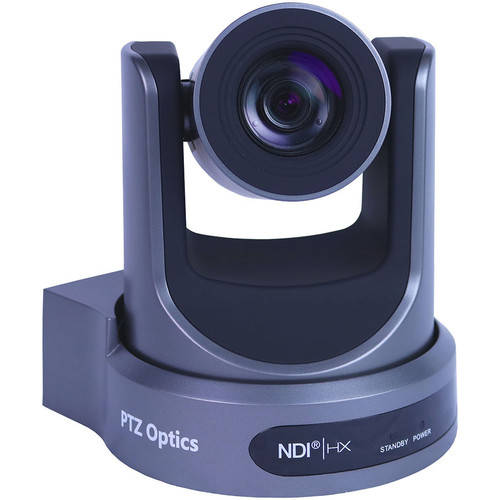
2. PTZOptics 12X-SDI
This camera is great for studio work. It’s got a sharp image in low light and a 3.5mm audio plug should you want to pull audio in from the camera itself (you’ll want the SDI version for this to work). As a production camera, it has PTZ controls that can be managed via an infrared (IR) remote that comes with the camera, through IP with a joystick available as a separate purchase, or with software. This can be an app for your phone or switcher software like OBS studio. Knowing their audience, PTZOptics uses RTSP signals, but this can be switched to RTMP.
These cameras require an Ethernet connection and also allow for Power over Ethernet (PoE). If you are working in a larger space, such as a church or football field, 20x and 30x options are available. Versions are also available that use the NDI protocol.
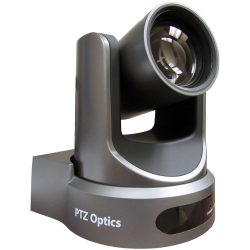
3. Canon CR-N300 4K NDI PTZ
If you need 4K and are willing to pay a little more, then this camera with 20x Zoom is an excellent option. Canon is a trusted brand, and having a superb 20x lens combined with a 1 / 2.3” CMOS Sensor sounds pretty good, right? Again, we also have Ethernet, SDI, and NDI options. Unfortunately, you’ll also need to get a control system because these cameras do not allow for plugins to most available encoding software. That said, this is the case for most camera manufacturers.
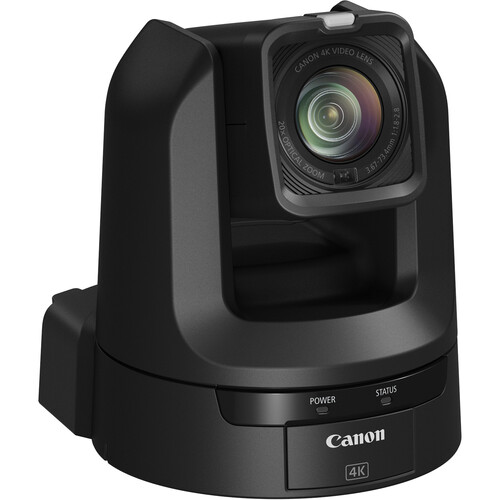
4. Sony SRG-X120 1080p PTZ Camera
This particular camera is similar in price to the Canon option mentioned above. However, in this section, we’re really referencing the entire x-series line. Ultimately, it comes down to what you need in terms of resolution, lenses, zoom, connections, etc. (and Sony is certainly a brand you want to consider). But if controls matter to you, then you can control x-series cameras with encoder software link Wirecast and Vmix. We’re big fans of making a production run smoothly, and having controls built into what we use to manage the entire production is a huge consideration.
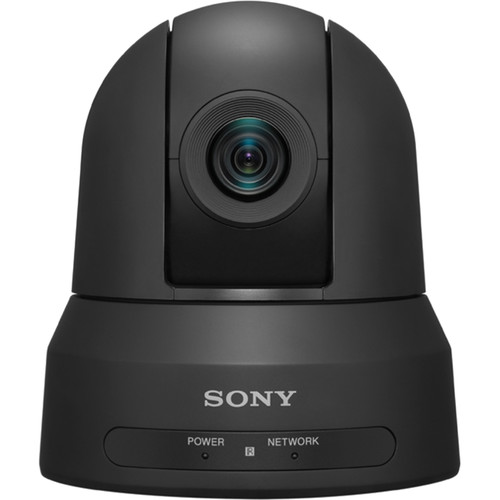
Best IP Cameras for Surveillance
Unlike with production, surveillance does not typically require a high degree of quality. Low-quality, high-security, and high-reliability streams are the bread and butter of most IP cameras. So, if quality isn’t top of your list, what cameras should you most consider?
5. Axis Communications
Axis Communications is well known in the surveillance industry. You can go on the cheap with a 720p dome camera or start getting pricey with a 4k camera that allows remote PTZ control. As commercial-grade equipment, these cameras are made to stream via RTSP, but PTZ controls can be managed directly through Wowza Streaming Engine.
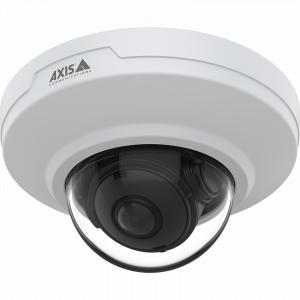
6. Reolink E1 Zoom
For something more consumer-oriented to use inside of the house, check out the Reolink E1 Zoom. Using an MP5 camera, it provides Super HD quality at 2560×1920. This can be down-converted for a sharp 1080p image. It also has PTZ options, with a 3x optical zoom, and will send an RTSP and RTMP signal if you want to go to social media. All of this is available over Wi-Fi, but unfortunately, there are no Ethernet ports or PoE capabilities.
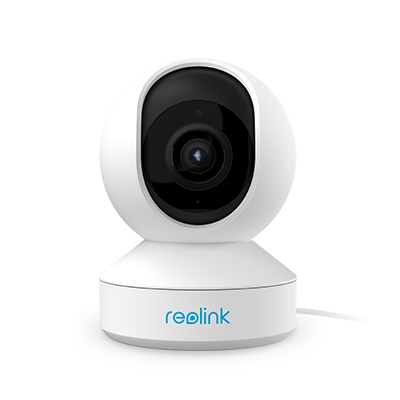
7. Reolink Argus PT IP camera
Many people have been excited about this camera for outside use. Why? No wires! It’s a 1080p using a Wi-Fi 2.4ghz network connected to a solar panel and containing a rechargeable battery. All that means you can put it almost anywhere under the sun – literally. Plus, the PTZ options are great for remote control from inside. If only it could recognize and follow vermin. Someday soon, we’ll all have a camera that will notify us when a rabbit is in the garden.
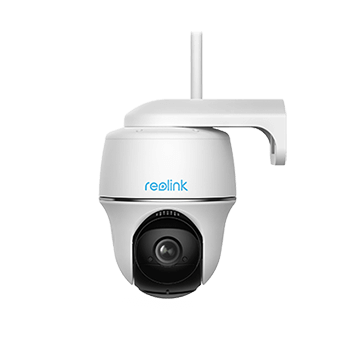
Best IP Camera Software
Selecting an IP camera is just part of the battle. You’ll also need to carefully consider the IP camera software with which you pair it. Different types of IP camera software offer a range of different features — including mobile access, recording, and intuitive interfaces for viewing live feeds. With dozens of IP camera software solutions on the market, the prospect of choosing just one might feel impossible. We’ve provided a brief breakdown of some of the most popular options.
Security Eye
This free security software works with almost any IP camera. It boasts features such as high-quality and programmable video recording, motion detection that sends out email and text alerts, and an integrated video player. Finally, Security Eye has full mobile access. So, what’s the downside? It works ONLY with Windows.
Xeoma
Xeoma is highly flexible security software that works with most IP cameras across Windows, iOS, and Linux, including mobile via cloud service and mobile app. Its features include sound detection (and recording with sound), password security, facial and emotional recognition, and the ability to capture screens from multiple monitors simultaneously. Xeoma has a free option, but it includes few of the listed features. Flexible payment options are available for additional functionality.
Anycam
Anycam’s IP camera software seems to have the corner on convenience and is particularly well-suited to a surveillance setup. This easy-to-use software can connect to new cameras with nothing more than an IP address or domain name. It also lets users store and play individual recordings. While there is no truly functional free version of this software, you can try Anycam for free on a single camera. Tiered pricing plans offer affordable solutions for personal, standard, and professional use. Of course, simplicity is not always the order of the day. Anycam lacks many of the bells and whistles you get from other IP camera software and does not work with mobile devices.
ContaCam
This IP camera software, provided by Contaware, was mainly designed for video surveillance. Its motion detection and daily summary videos streamline it for this purpose. That said, ContaCam also allows for manually creating recordings and screenshots, versatile features that lend themselves to other uses. ContaCam is available in several languages and runs on Windows, iOS, and LINUX (although it was designed specifically for Windows). With regular updates and a lack of bloatware, it is clean and reliable software – just don’t expect it to run on your mobile device.
iVideon
Free and trustworthy is the name of the game with iVideon. This software won’t blow your socks off. Even the facial recognition software it boasts is mediocre at best. However, it is trustworthy and straightforward. View live and recorded video feeds on your smartphone or desktop. Add and remove users with ease. Get smart notifications. Integrate it with your corporate management systems. iVideon might be light on features, but it is robust where it counts — reliability.
Wowza
Of course, sometimes out-of-the-box streaming solutions aren’t enough. Consider Wowza for a customized IP camera streaming solution. Our solutions can ingest IP camera live video and transcode it for high-quality streaming across a wide range of devices. Consider our Wowza Streaming Engine software or Wowza Video platform to build the best solution for your needs.
DIY Equipment Recommendations – Build Your Own IP Camera
Building an IP camera is a fun option for those looking to do it yourself. We’ll emphasize fun here and certainly education — as it’s not necessarily easy or any more cost-effective.
One of our video producers here at Wowza built IP cameras using a Raspberry Pi Zero W (W denotes built-in Wi-Fi), Raspberry Pi Camera Module V2, and Raspberry Pi Zero Case (see the Raspberry Pi product list here). Using v4l2 RTSP server software, you can get an IP camera up and running with an RTSP stream in about 15 minutes. However, he runs OctoPrint to manage and monitor his 3D printer farm for his needs. For those interested in a 2020 extrusion mounting option, check out his Thingiverse designs with and without the Pi Zero Case.
For a more comprehensive tutorial, check out this one for building a highly affordable IP camera for home security or this one for an ESP32 Wi-Fi CCTV home surveillance camera.
Recap: IP Cameras At a Glance
- PTZOptics 30xNDI – $1800 – $2400
- PTZOptics 12X-SDI – $1500 – $1600
- Canon CR – N300 4K NDI PTZ – $1900 – $2700
- Sony SRG-X120 1080p PTZ – $1800 – $2100
- Axis Communications – Varies
- Reolink E1 Zoom – $80
- Reolink Argus PT IP – $160
These prices reflect what you’re likely to find at popular retailers. All prices vary seasonally and with additional deals and functionality. Need assistance jumpstarting your live video monitoring and surveillance system? Wowza can help.




